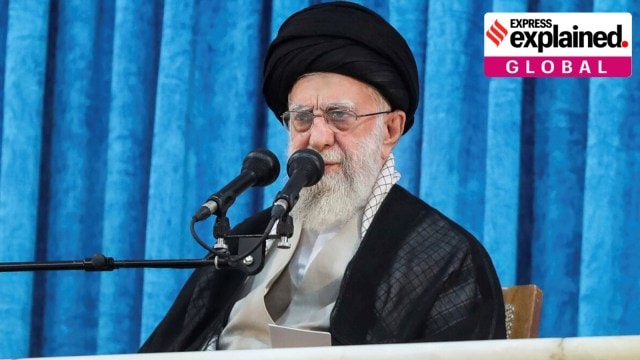Iran's Supreme Leader: Unpacking The Ayatollah's Enduring Influence
In the intricate tapestry of global politics, few figures wield as much concentrated power and influence as the Supreme Leader of Iran. This singular position, deeply rooted in the nation's revolutionary past, stands at the apex of the Islamic Republic's unique governance structure, blending democratic elements with theocratic oversight. Understanding this role is crucial to comprehending Iran's domestic policies, its foreign relations, and its trajectory on the world stage.
At the heart of this system is Ayatollah Ali Khamenei, who has served as the Supreme Leader of Iran since 1989. His tenure, spanning over three decades, has seen the nation navigate complex geopolitical landscapes, internal challenges, and significant socio-economic shifts. This article delves into the origins of the Supreme Leadership, the journey of Ayatollah Ali Khamenei to this powerful office, his enduring impact, and the mechanisms that underpin this pivotal role in one of the world's most strategically important regions.
Table of Contents
- The Architect of Modern Iran: Ayatollah Ruhollah Khomeini
- Overthrowing the Shah and Founding the Islamic Republic
- Ayatollah Ali Khamenei: From Revolutionary Aide to Supreme Leader
- Biography and Early Life
- The Role and Powers of Iran's Supreme Leader
- Election and Tenure of the Supreme Leader
- Khamenei's Leadership: Decades at the Helm
- Key Moments and Foreign Relations
- The Assembly of Experts: Guardians of the Leadership
- The Future of the Supreme Leadership
The Architect of Modern Iran: Ayatollah Ruhollah Khomeini
The story of the Supreme Leader of Iran begins with Ayatollah Ruhollah Khomeini, the charismatic figure who spearheaded the 1979 Iranian Revolution. Khomeini led Iran for ten years after toppling the country's last Shah, Mohammad Reza Pahlavi. This monumental event not only reshaped Iran's political landscape but also sent ripples across the Middle East and beyond, establishing a unique form of governance known as the Islamic Republic. Khomeini's vision for Iran was a state governed by Islamic principles, where religious scholars would play a central role in guiding the nation. He instituted the post of Rahbar ("Leader") in 1979, blending democratic elements with theocratic oversight from Islamic clerics of the Twelver Shiʿi sect. This new system fundamentally altered the power dynamics within Iran, placing the Supreme Leader at the very top, overseeing virtually all functions of government, either directly or indirectly. His leadership during the formative years of the Islamic Republic, including the challenging period of Iran’s war with neighbouring Iraq (1980-1988), known in Iran as the "Sacred Defense," solidified his position as the founding father and first Supreme Leader of Iran.Overthrowing the Shah and Founding the Islamic Republic
Mohammad Reza Pahlavi, the last Shah of Iran, had ruled for decades, attempting to modernize the country along Western lines. However, his autocratic rule, perceived corruption, and the suppression of dissent fueled widespread discontent. Ayatollah Ruhollah Khomeini, an exiled cleric, became the rallying point for this opposition. His powerful speeches, smuggled into Iran, ignited the revolutionary fervor that eventually led to the Shah's overthrow in 1979. Following the revolution, Khomeini returned to Iran to an ecstatic welcome, marking the beginning of the Islamic Republic. The new constitution established the Supreme Leader as the ultimate authority, ensuring that the government's policies aligned with Islamic principles. This transition was a profound shift from a monarchy to a unique religious-political system, setting the stage for the enduring influence of the Supreme Leader of Iran.Ayatollah Ali Khamenei: From Revolutionary Aide to Supreme Leader
Ayatollah Ali Khamenei's journey to becoming the Supreme Leader of Iran is a testament to his strategic acumen, resilience, and deep involvement in the revolutionary movement. Born in 1939 into a religious family of modest means in Mashhad, a pilgrimage city in eastern Iran, Mr. Khamenei came of age in the years leading up to the revolution. He was a close ally of Iran's first Supreme Leader, Ayatollah Ruhollah Khomeini, the figure who led the country's 1979 revolution that overthrew Pahlavi and founded Iran's Islamic Republic. Khamenei played a significant role in the 1979 Iranian Revolution, rising through the clerical ranks. His dedication to Khomeini and the revolutionary cause saw him assume prominent positions in the nascent Islamic Republic. He served as president of Iran from 1981 to 1989, a critical period that included much of the Iran-Iraq war. This experience provided him with invaluable insights into the complexities of governance and statecraft. Upon Ayatollah Khomeini's death in 1989, Khamenei was chosen by the Assembly of Experts to succeed him, becoming Iran's Rahbar, or Leader, and the second and longest-serving Supreme Leader of Iran.Biography and Early Life
Ayatollah Ali Khamenei's early years reveal a man of eclectic tastes, engaging with Iranian intellectuals and absorbing both secular and Islamist ideas. This intellectual breadth, combined with his religious upbringing, shaped his worldview and prepared him for the pivotal role he would eventually assume. Here is a summary of his personal data and biodata: | Attribute | Detail- How Old Is Jonathan Roumie Wife
- Yinyleon Height
- Lil Jeff Kills
- Alaina Eminem Daughter
- Claire Anne Callens

Who is Ayatollah Ali Khamenei, the Supreme Leader of Iran? | Explained

Iran's Khamenei Responds to Trump Threats: 'Cannot Surrender' - Newsweek

Who is Iran's supreme leader? Ali Khamenei vows not to surrender